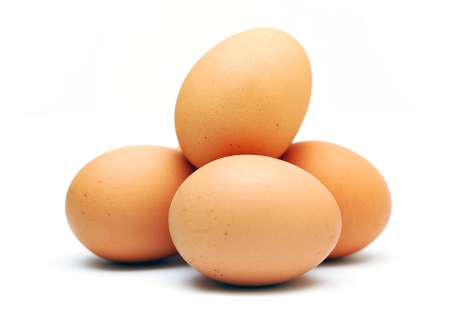I found this article at Sign on San Diego. It is a geat article on the value of these “other” egg products that we see in stores. I only eat eggs on the weekend when I am hungry for a bigger breakfast with the kids and have always wanted to know more about these eggs. I bought them once and they tasted like eggs but just never bought them again…
Remember the days when shopping for eggs was just a question of large or jumbo?
The Emergence of 100 Types of Eggs
Today’s supermarkets present dizzying choices: “free-roaming,” “omega-3,” “100 percent organic,” “cage-free,” “compatible with cholesterol-reducing diet,” “natural sunlight,” “hand-gathered,” “vegetarian diet,” “high vitamin E,” “humane harvest,” “vegetarian hens with roosters.”
 It’s a trend born of the egg’s new and improved nutritional rap and fueled by the zeal of low-carb dieters. And these designer eggs bear designer prices.
It’s a trend born of the egg’s new and improved nutritional rap and fueled by the zeal of low-carb dieters. And these designer eggs bear designer prices.
So what makes them different? It boils down to two things: what the hens eat and how they are housed.
The speciality eggs getting the most attention are from hens fed a diet engineered to cut down on the yolks’ fat and cholesterol and to boost certain nutrients especially omega-3 fatty acids, which studies have linked to heart, brain and eye health.
Flax, kelp, marine algae and vitamin E supplements are most often cited as the diet additives that enhance eggs’ omega-3 nutritional profile. Marigolds boost the amount of lutein, which may promote good vision, as well as giving the yolks a more intense hue.
The nation’s top-selling enhanced eggs, Eggland’s Best, boast 100 milligrams of omega-3 in each egg, almost three times the typical 35 milligrams, as well as 25 percent less saturated fat than ordinary eggs. They also claim 180 milligrams of cholesterol, as opposed to the typical egg’s 215, and 10 times the amount of vitamin E.
Eggland’s Best says a special diet of grains, canola oil, rice bran, alfalfa meal, kelp and vitamin E is behind its pumped-up eggs, which generally cost more than twice as much as regular eggs.
The cost doesn’t appear to be deterring buyers. Eggland’s Best reported a 21 percent sales increase in 2004.

Are the nutritional claims accurate? Last year Consumer Reports tested the amounts of the omega-3 fatty acid DHA and vitamin E in a popular specialty brand, Gold Circle Farms Cage Free eggs. The tests found the nutrients to be in line with the claims on the label.
In terms of whether the benefits justify the cost, though, the picture is a little less clear.
Some types of omega-3 fatty acids are more helpful to the body than others. Many of the high-omega-3 eggs contain only a less potent type called ALA, and some don’t contain EPA, which the American Heart Association recommends along with DHA for the best heart benefits.
Certainly, oily cold-water fish such as salmon are a better source of DHA. Consumer Reports notes you would have to eat more than a dozen of the Gold Circle eggs a week to get the amount of DHA you would get in two 3-ounce servings of farmed Atlantic salmon.
And even if you’re avoiding high-oil fish because of fears of mercury contamination, the magazine said, fish oil pills are cheaper than the designer eggs.
But Anne Van Beber, associate professor and chairman of the department of nutritional sciences at Texas Christian University, believes it’s “always better to get your nutrients in food because they’re packaged along with other nutrients that work in synergy.”
For someone who won’t eat fish, like her son, she said, eggs are an excellent way to get more omega-3s.
“I feed my son an egg almost every day,” said Van Beber. She’s “a big fan of eggs in general” for their protein, vitamin and mineral content. And, although she complains about their cost, she buys the omega-3-enhanced Eggland’s Best or Eggs Plus.
“I really do think in the long run it’s worth it to pay the extra price for the DHA, the EPA and the extra vitamin E,” she said.
Van Beber is one consumer who thinks the enhanced eggs “taste really fresh and have more flavor,” though taste tests tend not to bear her out. A blind taste test last year by the San Francisco Chronicle food staff, for example, didn’t find any significant differences in flavor among 19 brands of specialty and regular eggs.
There’s little doubt in the minds of many consumers that true “yard eggs,” from pasture-raised hens, taste richer than regular supermarket eggs, but it’s unlikely that any eggs you buy at the grocery came from hens that wandered the barnyard, pecking and scratching.

“Cage-free” simply means the hens’ coops don’t crowd them so closely into a confined space that they can’t move around. If the eggs are “free-range,” that probably means the coops have openings that let the hens roost outside.
“Fertile eggs” indicates the hens get to interact with roosters.
Is it worth it to pay extra for better poultry living conditions? There’s probably less risk of bacterial contamination in eggs from hens that aren’t crowded closely into cages, but for many it simply boils down to humane considerations.
There’s more on the horizon for designer eggs. In Canada, the Edmonton Journal reports University of Alberta researchers are developing an egg with an immunoglobulin that may reduce allergic reactions to the gluten in wheat.



